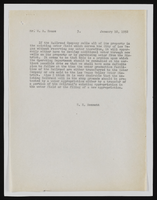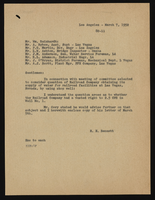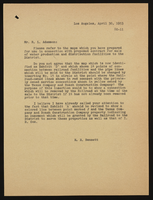Search the Special Collections and Archives Portal
Search Results
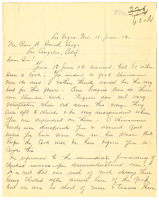
Letter from J. K. W. Bracken to Ross W. Smith, June 18, 1903
Date
Archival Collection
Description
Text
General Manager, Manager of Properties, and Manager of Industrial Development in Los Angeles, California, 1900-1976
Level of Description
Scope and Contents
The General Manager, Manager of Properties, and Manager of Industrial Development in Los Angeles, California sub-series (1900-1976) consists of information related to the physical development of Union Pacific railroad towns and sites outside of Las Vegas, Nevada, including Yermo, California. Files include building leases, sales and purchases of land and water, accounting and other business practices, legislative matters, and industrial development along the Union Pacific rail routes.
Archival Collection
Collection Name: Union Pacific Railroad Collection
Box/Folder: N/A
Archival Component
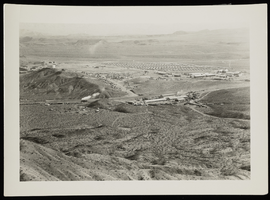
Aerial photograph of Boulder City (Nev.), circa 1933
Date
Archival Collection
Description
Image
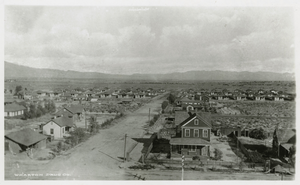
Postcard of Main street at Bonneville, Las Vegas (Nev.), 1912
Date
Archival Collection
Description
Caption: Wharton Drug Co.
Image
Roy Waite oral history interview
Identifier
Abstract
Oral history interview with Roy Waite conducted by Dale Haley in approximately 1974 for the Ralph Roske Oral History Project on Early Las Vegas. Waite begins by discussing his athleticism, being a part of the first basketball team in Las Vegas, Nevada, and his general store in Bunkerville, Nevada. Waite lists the different social organizations and boards he was affiliated with, describes the arrival of the railroads, and the ranch he used to own near Bunkerville. He talks about the construction of Hoover Dam (Boulder Dam) and how Southern Nevada has changed socially and environmentally. Waite also discusses smelting lead for bullets and relocating Native American remains away from a grave site that would be submerged by Lake Mead.
Archival Collection


